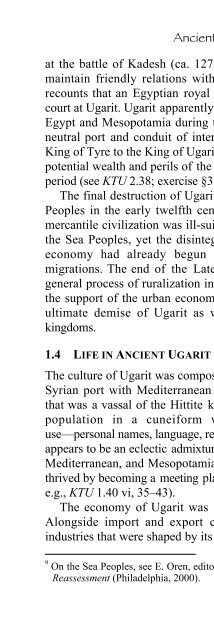A Primer on Ugaritic: Language, Culture, and Literature - enenuru
A Primer on Ugaritic: Language, Culture, and Literature - enenuru
A Primer on Ugaritic: Language, Culture, and Literature - enenuru
You also want an ePaper? Increase the reach of your titles
YUMPU automatically turns print PDFs into web optimized ePapers that Google loves.
Ancient Ugarit 15<br />
at the battle of Kadesh (ca. 1276 BCE). Ugarit still managed to<br />
maintain friendly relati<strong>on</strong>s with Egypt. One stele, for example,<br />
recounts that an Egyptian royal scribe was assigned to the royal<br />
court at Ugarit. Ugarit apparently served as a buffer state between<br />
Egypt <strong>and</strong> Mesopotamia during this period, <strong>and</strong> it prospered as a<br />
neutral port <strong>and</strong> c<strong>on</strong>duit of internati<strong>on</strong>al trade. A letter from the<br />
King of Tyre to the King of Ugarit, for example, illustrates both the<br />
potential wealth <strong>and</strong> perils of the flourishing maritime trade of this<br />
period (see KTU 2.38; exercise §3.9).<br />
The final destructi<strong>on</strong> of Ugarit usually is attributed to the Sea<br />
Peoples in the early twelfth century BCE. 9 To be sure, Ugarit’s<br />
mercantile civilizati<strong>on</strong> was ill-suited to withst<strong>and</strong> the <strong>on</strong>slaught of<br />
the Sea Peoples, yet the disintegrati<strong>on</strong> of Ugarit’s palace-temple<br />
ec<strong>on</strong>omy had already begun well before the Sea Peoples’<br />
migrati<strong>on</strong>s. The end of the Late Br<strong>on</strong>ze Age was marked by a<br />
general process of ruralizati<strong>on</strong> in the countryside that undermined<br />
the support of the urban ec<strong>on</strong>omy <strong>and</strong> ultimately exacerbated the<br />
ultimate demise of Ugarit as well as other Late Br<strong>on</strong>ze Age<br />
kingdoms.<br />
1.4 LIFE IN ANCIENT UGARIT<br />
The culture of Ugarit was composite. It was all at the same time: a<br />
Syrian port with Mediterranean trade, a west Semitic city-state<br />
that was a vassal of the Hittite kingdom, <strong>and</strong> a Northwest Semitic<br />
populati<strong>on</strong> in a cuneiform world. Whatever measure we<br />
use—pers<strong>on</strong>al names, language, religi<strong>on</strong>, or material culture—Ugarit<br />
appears to be an eclectic admixture of Syrian, Canaanite, Egyptian,<br />
Mediterranean, <strong>and</strong> Mesopotamian cultures. Ugarit seems to have<br />
thrived by becoming a meeting place of Near Eastern peoples (see,<br />
e.g., KTU 1.40 vi, 35–43).<br />
The ec<strong>on</strong>omy of Ugarit was naturally dominated by the sea.<br />
Al<strong>on</strong>gside import <strong>and</strong> export c<strong>on</strong>cerns, Ugarit also developed<br />
industries that were shaped by its maritime locati<strong>on</strong> such as purple<br />
9 On the Sea Peoples, see E. Oren, editor, The Sea Peoples <strong>and</strong> Their World: A<br />
Reassessment (Philadelphia, 2000).


